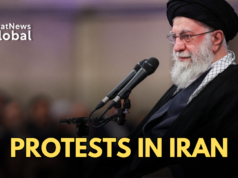Masoud Pezeshkian has represented the people of Tabriz for five terms in the Majlis and had been the health minister from 2001 to 2005 during Mohammad Khatami’s presidentship. He garnered the support of moderates like Khatami and Mohammad Javad Zarif, former foreign minister.
On the other hand, Jalili, also known as ‘Living Martyr’ due to losing one of his legs during the Iran-Iraq war, is a hardliner who is close to Supreme Leader Khamenei and represents the conservative camp in Iranian politics. He was chief nuclear negotiator while Secretary of the Supreme National Security Council from 2007 to 2013.
A Reformist President: An Anomaly among the Hardliners
It can be argued that Pezeshkian, unlike in 2021, was allowed to contest this time by the Guardian Council, a powerful 12-member body that vets the candidates before the elections, so that he can get liberal-minded Iranians, who may have lost faith in their government and may have been planning to boycott the elections, to come out and vote.
The ‘Boycott Elections’ campaign had been gaining traction on social media since the polls were announced. It is pertinent to note that the Islamic Republic has been struggling with a legitimacy crises at home since long. This could be witnessed in the 2022 nationwide protests of Women, Life, Freedom’ (Jin, Jiyan, Azadi), a movement that shook the country for months.
The public disillusionment with their government can also be seen in the elections to the Majlis, the Iranian parliament, and the Assembly of Experts, both of which were held in March and the turnout was low at 41%.
A humiliating low turnout in the presidential election would have worsened the legitimacy crises for the Islamic Republic. Addressing this was urgent as Iran may have to look for a successor to the 85-year-old Supreme Leader whose deteriorating health and old age is a cause of concern.
The near 50% voter turnout is suggestive of Iranians’ faith in the Islamic Republic and is face-saving for regime loyalists.
Limited Hope
This election turned out to be quite like the 2005 presidential election where the political debate got polarised by the reformist-conservative divide. In the fiery one-on-one presidential debates between Pezeshkian and Jalili, which took place for the first time since the 2005 elections, we witnessed a clear reflection of the two major political ideologies in Iran.
Jalili embodies the hardline approach endorsing confrontational foreign policy and socially restrictive domestic policy, whereas Pezeshkian called for a moderate foreign policy favouring engagement with world powers and ease in restrictions pertaining to social issues like strict hijab enforcement. Having both Azeri and Kurdish roots, he advocated for the rights of minorities and endorsed a policy of inclusion.
Masoud Pezeshkian’s victory has renewed hope in some people that meaningful reforms can happen. Others do not think that the victory of the reformist camp can bring any change in the socio-political landscape of the country since the Supreme Leader wields real power.
Even Pezeshkian has not made any promises during his campaign to bring radical change and has, in fact, stated that he is committed to the ideals of the Islamic Republic.
It is important to note that regardless of the reformist victory in the presidential election, all other political institutions in the country like the Parliament, Expediency Discernment Council, Supreme National Security Council, Iranian Revolutionary Guard Corps including the office of the Supreme Leader, are dominated by hardliners.
Conclusion
While the office of the Supreme Leader is constitutionally the most powerful in Iran, the presidential position should not be undermined. Since 1989 Iran has seen five different presidents and despite the Supreme Leader’s utmost power, one can see a clear difference in the way the policies have been shaped during each president’s tenure.
For instance, Iran’s foreign policy witnessed Ahmadinejad’s confrontational policy approach with the West followed by Rouhani’s policy of engagement, which culminated into the JCPOA agreement of 2015. This was followed again by a hardline approach as the late President Ebrahim Raesi assumed office in 2021.
While the Supreme Leader has the final say on the matter of national security, the president may get to shape the discourse as to how it can be achieved. Pezeshkian’s formidable challenge lies in constantly navigating between supporters demanding reform and the dispensation which favours the status quo.
Research Analyst at NatStrat




